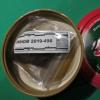
07-01-2026 10:24
 Danny Newman
Danny Newman
Pezicula sp. on indet. hardwood Appalachian Highl

07-01-2026 22:22
 Danny Newman
Danny Newman
Tatraea sp. on indet. hardwood The Swag, Great Sm

07-01-2026 17:29
 Marc Detollenaere
Marc Detollenaere
Dear Forum,On a barkless Populus I found some smal

10-11-2021 17:33
 Riet van Oosten
Riet van Oosten
Add-on topic http://www.ascofrance.com/forum/7059

07-01-2026 10:05
 Danny Newman
Danny Newman
cf. Chaetospermum on XylariaCosby Campground, Grea

02-01-2026 17:43
MARICEL PATINOHi there, although I couldn't see the fruitbody, I

04-01-2026 17:45
 Stephen Martin Mifsud
Stephen Martin Mifsud
I was happy to find these orange asmocyetes which
 Hi,
Hi,I found a second specimen of Orbilia caudata-like. It was at the different location. I have a fresh specimen. It was on Ulmus. I took pictures of the tree and a sample of wood.
On the same branch, I also found Orbilia pilifera. The same conidia were present in both specimens.
#825 https://www.inaturalist.org/observations/74272664
(#496 from Nov 2019 - https://inaturalist.ca/observations/35958367)
I didn't hear from Guy Marson, so I don't know if he received my first specimen or if it got lost, but in any case, now I have more information and more material.
Igor

You probably mean the second mailing. See image below.
The material has arrived on 12-Mar-2021. Very robustly packaged, like the first shipment. I tried a PCR of the first material but without success. My primers are contaminated, new ones have been ordered but have not yet arrived. As soon as I get results, I'll let you know.
Best wishes,
Guy

Thank you Guy for the update. It is good to know that you got it. I had some doubts.
Now I have a much better specimen of O. xanthoguttulata (#779 https://inaturalist.ca/observations/72036555) from Salix discolor. The largest apothecium was 2.5mm. It was next to O. eucalypti, ?O. caudata, Helicogonium orbiliarum and Hysteropatella prostii.
For O. caudata I found only two small cups mixed with abundant O.eucalypti, so I don't have material left but I got some pictures (#779B https://inaturalist.ca/observations/72050060).


(#705 https://inaturalist.ca/observations/67150789).
If you think it is a host-specific species then I will change it.
I also observed Hysteropatella on Ulmus and the spores were even smaller, but there is a chance they were not mature enough.

1. Spores max. 28 × 9.3 µm .. 2
2. Spores *18–25(–28) × 6–8(–8.5) µm, light to medium brown, 3-septate, rarely a few spores with 4–5 septa, ?shape, asci *80–96 × 13.5–15 µm, paraphyses in H2O with a greyish-blue gel exudate among their subapices, on exterior of bark of still–attached dead corticated twigs of Salix, mainly seated on the ostioles of a dothidealean pyrenomycete, Europe .. H. elliptica
2. Spores *14–22(–26) µm long, 3–septate, very rarely few spores with only 2 or with 4–5 septa, gel exudate among tips of paraphyses olivaceous–brownish or greyish-lilaceous, never bluish (in H2O!), paraphyses *2–3.7 µm wide (prostii) .. 3
3. Spores KOH 13.5–20 × 4.7–6 µm, more fusoid–clavate, ± straight, asci in KOH 10.5–13 µm wide, on corticated twigs of Ulmus, Cornus, ?Acer, USA .. H. maura ("americana")

I didn't use any key for my identification. I made my assumption based mostly on spores size alone and considered only two options H. elliptica and H. prostii.
I see that my specimen from Ulmus has not only smaller spores but lilaceous color of gel exudate among tips of paraphyses.
Could it be H. maura ("americana")?
#710 - https://inaturalist.ca/observations/67391232
For the specimens on Salix, I don't see greyish-blue gel exudate among tips of paraphyses and spores are small, so I tend to think it is more resemble H. prostii.
I probably need to collect more specimens and get more data.
Thanks,
Igor




